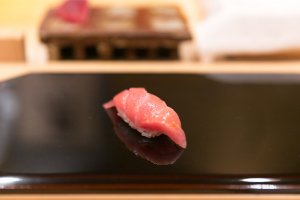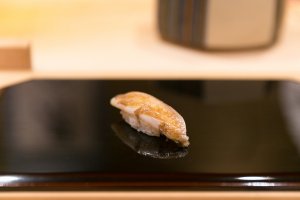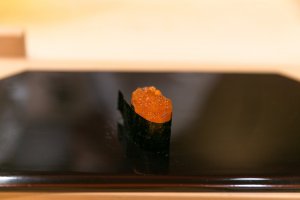Overview
Sushi literally means vinegared rice and it's often said that good sushi is 70% of the stuff. Yet for most people, it's hard to imagine sushi without a topping. And with so many toppings it might seem confusing knowing which is which. Fortunately, sushi's toppings tend to fall into several fairly neat categories. Here are the four basic sushi topping types.
Akami (red fish)
Red fleshed fish are called akami and are generally cut lean to have a firm, thick and an almost sticky texture. Their strong but non-fishy flavours tend to see them being served midway through a course. Popular akami fish include the famous tuna (maguro) as well as bonito (katsuo), trout (masu) and herring (nishin).

Shiromi (white fish)
Fish with white meat are known as shiromi. Shiromi toppings tend to be low in fat, subtly flavoured and have a certain crunch to their texture. Popular shiromi include flounder (hirame), sea bream (tai) and sea bass (suzuki). Depending on the strength of their flavour, in most courses, shiromi are served early to midway through the meal.

Hikari mono (silver-skinned fish)
Sometimes known as blue-skinned fish, hikari mono toppings are characterised by their shiny surfaces, higher fat content and strong fishy flavours and aromas. Popular toppings include sardine (iwashi), mackerel (saba) and gizzard shad (kohada). Their vibrant flavours see hikari mono served early to midway through a course.

Nimono (simmered toppings)
Toppings that have been simmered, usually in a special broth, are called nimono. Often coated with a tsume sweet glaze, nimono are usually served towards the end of a course. Common nimono toppings include conger eel (anago), octopus (tako), squid (ika), mantis shrimp (shako) and shellfish like clam (hamaguri).

Anything else?
Beyond these four basic sushi toppings lie seafood items like salmon roe (ikura), flying fish roe (tobiko), minced tuna (negitoro) as well as non-seafood items like egg (tamago), fermented soy beans (natto) and cucumber (kyuri). Usually served at the end, these kinds of toppings are like a final flourish to a sushi course.




































